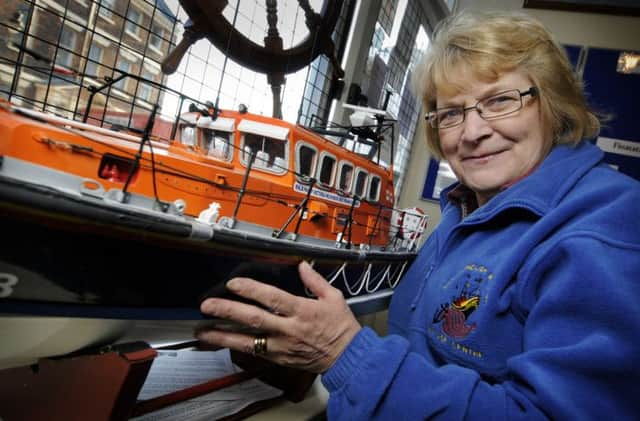Keeping history alive as time and tide move on


Lindy Rowley is a serial volunteer. That has more than a little to do with the fact that she was made an MBE some years ago. Cubs, Scouts, hospice, cystic fibrosis, Samaritans: there is no end to the causes she’s become committed to over the years.
“The thing is being married to a fisherman is only half a marriage because for 50 per cent of the time your husband is away at sea,” she says, partly explaining how she has found the time to help so many organisations.
Advertisement
Hide AdAdvertisement
Hide AdLindy and her husband, Tom, live in Longwestgate, the centre of the old town’s fishing community; over the road from where husband Tom was born and five doors along from Sir Alan Ayckbourn. They have a son (also named Tom), who has left Scarborough for Portsmouth where he is a Lieutenant Commander in the Royal Navy. Tom, is of Irish stock. His folk came over from County Mayo three years after the 1847 potato famine and settled in the Scarborough workhouse.
“Catherine Rowley was my great great great grandmother,” he says. “But her husband John passed away not long after coming here and she took up with a Scarborough lighthouse keeper who became stepfather to her four sons.” Succeeding generations of Rowleys were stuck with two strands in their dynasty: a maritime life and the name Tom for every first born male. All this may appear to have little to do with Lindy’s inclinations to volunteer herself for just about any worthwhile community venture but it provides the background to her most ambitious project to date. When her father-in-law retired from the boats many years ago, he set about recording his life at sea. However, he needed some help and Lindy volunteered to do the leg work. He built up four albums of memorabilia, a testimony to a life at sea and of courage and daring.
In the process of helping her father-in-law to compile his life record, Lindy came to realise that in the Scarborough old town a whole fishing generation was dying off and there would soon be nothing to remember them by. She went to countless funerals and witnessed numerous house clearances that only hammered home the fact that an entire way of life was disappearing from the town’s collective view. Lindy talked to a chap from the Council for Voluntary Services and told him her idea of setting up a maritime museum.
“Get a group of six like-minded people,” he advised. Lindy and her husband found those six people and set up a series of meetings. Then they came across Scarborough historian John Rushton.
Advertisement
Hide AdAdvertisement
Hide Ad“Sadly John is no longer with us,” Lindy says, “but his first words were ‘in this museum you’re planning don’t just do fishing’.
“There’s the Captain Cook museum at Middlesbrough and then there’s nothing down the east coast until you reach Filey Cottage Museum,” he had said. “All the things that happened along that stretch need recording.”
College of Ripon and York St John lecturer Steven Friend added another vital dimension with his women’s voices project. Up and down the east coast he gathered recordings of fishermen’s wives, their dialect and anecdotes.
Small projects gave a boost to the Maritime Museum’s development.
Advertisement
Hide AdAdvertisement
Hide AdInstead of watching on while fishermen’s houses emptied as they passed on or left home, Lindy began collecting items and storing future exhibits in lock-up garages, bedrooms and boatyards, but the problem of where to put it could only be shelved for so long. The big breakthrough came in 2007-08 when the Government encouraged towns to make creative use of empty shops rather than let them rust and decay.
“We got a shop on Eastborough.It had been empty for two years and a chap from Scarborough Council came up with a grant that paid for carpet and paint. It had enough space for us to use it as a meeting room.”
Things though are reaching bursting point despite the fact that the group shares a warehouse in Quay Street with the town’s archaeological and historical societies. It is not only the exhibitions, but the visits from schools, Women’s Institutes and church groups.
“People come from as far away as Australia because they’ve heard about us through the internet. It gets 5,000 hits a week,” says Lindy. “Visitors expect to arrive and find this vast museum, but it’s just a tiny little shop on Eastborough”
Advertisement
Hide AdAdvertisement
Hide AdHusband Tom has no doubt about what drew people to the windows of the Eastborough office.
“It’s the boat models in their glass cases. People look at them in the shop front and we have to tell them that the models are not for sale.”
But the money and space is running out and a new home is needed.
As the exhibits increase, there is a problem of storage and storage costs. Although volunteers ensure the museum continues, the quality needed requires investment.
Advertisement
Hide AdAdvertisement
Hide Ad“Nearly all of our funding goes on the rent,” Lindy admits.
The centre has come up with one idea for raising money: a donation of £100 or more gets the donor a place on the roll of honour that will be displayed in the new building.
The only alternative futures would appear to be patronage by a firm that owes its commercial future to what comes out of the sea – or cash from the National Lottery. Current chairman Mark Vesey, a Londoner by birth but a Scarborian by adoption, is crystal clear about the importance of this project.
“A town without a museum at its heart,” he says, “is a town that is lost.”
www.scarboroughs maritimeheritage.org.uk